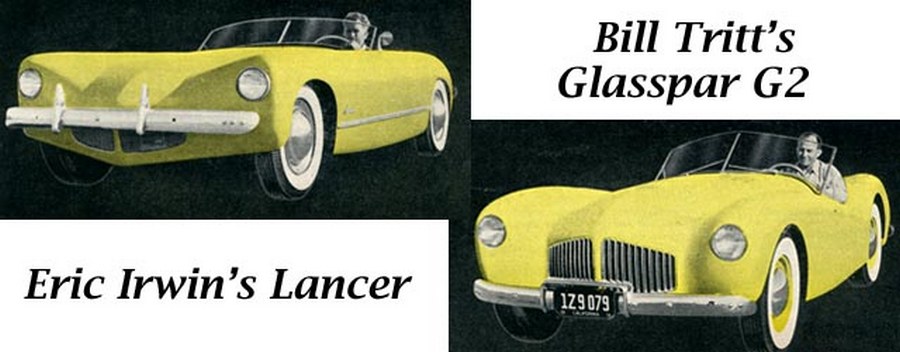
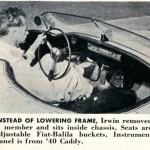
I Love The Detail In These Captions. Here It Says, “Instead of Lowering Frame, Irwin Removed X member and Sits Inside Chassis. Seats Are Adjustable Fiat-Balila Buckets. Instrument Panel Is From 1940 Caddy.”
Hi Gang…
Fiberglass cars were introduced to the public at the November 1951 Petersen Motorama to great acclaim. Two of the cars produced were designed and created by Bill Tritt and Eric Irwin of Costa Mesa, California. Not only did Bill and Eric compete and build sports cars of different design – they were good friends too.
I first learned this in a series of interviews I did with Bill Tritt beginning in 2006. Bill shared with me that when he was building his G2, his friend Eric Irwin was building a car too. For 1-2 years, Bill and Eric were next door neighbors on Industrial Way in Costa Mesa California. Each, no doubt, influenced the other on fiberglass construction, fiberglass technique and automobile body design.
Even though Tritt and Irwin worked closely together when they were building their cars, each used very different techniques to produce their bodies. Eric used a “male-mold” to create his Lancer body. Bill had chosen the alternative method of construction for his G2 body which utilized a “female-mold.”
Two competitors….two friends….two cars….two methods of construction. Both helped the other with the completion of their car. What better example of camaraderie could there be for fiberglass enthusiasts of all marques today than the friendship between Bill Tritt and Eric Irwin – who collaborated and created the foundation of the fiberglass sports car hobby that we all have come to enjoy and appreciate.
“Hats off” to these gentlemen of fiberglass!
An early article on both cars appeared in the March 1952 issue of Popular Science. Let’s take a look at this article in a bit more detail.
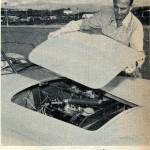
This Photo Shows Ken Brooks At Work On The G2. “Hood Panel Lifts Right Off, Providing Easy Access to Engine. The Power Plant Is A Modified L-Head Four Cylinder 1941 Willys With a 7.5 to 1 Compression Ratio.”
Plastic Sports Cars Are 500 Pounds Lighter (Popular Science, March 1952)
I’ve re-typed the article below to make it easier for all to read:
“Light, tough, easy to repair and lovely to look at, plastic bodies are a new idea in auto design.
There may be a plastic car in your future. Take a look at these two custom roadsters, which have bodies of molded Plexiglas. Their builders claim several advantages for this type of construction:
* An average savings of a quarter-ton in body weight lightens the load at the top – lowering the car’s center of gravity and helping it hug the road.
* Use of lighter body material also decreases gas consumption and hops up performance, with the same horsepower and over-all car dimensions.
* Seamless construction enhances streamlining.
* Plastic skin is tough, yet easy to repair – you simply sand and fill in with the same material.
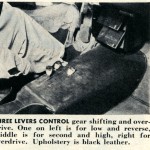
Detail Shown In This Caption On The Lancer Says, “Three Levers Control Gear Shifting And Overdrive. One on Left Is For Low And Reverse, Middle Is For Second And High, Right For Overdrive. Upholstery Is Black Leather.”
The body of the car pictured below was formed by laying three plies of Plexiglas over a plaster mold. Designed and built by owner Eric Irwin of Costa Mesa, California, the body weighs 225 pounds; the car 2220 (lbs).
The flowing lines of the roadster on this page were similarly created from three layers of Plexiglas, but formed inside a plaster mold. Built by designer Bill Tritt for USAF Major Kenneth Brooks, the body scales 185 pounds – a tenth the car’s total weight.
Both Irwin and Tritt plan to manufacture the plastic bodies. Irwin expects to market a plastic-bodied Ford chassis powered by a modified V-8. Tritt will supply bodies only.”
Thoughts on the Article:
First: This article appeared very early on in the history of fiberglass cars. The first article to appear on building your own fiberglass car was authored by Eric Irwin and used his Lancer as an example. That article appeared in the November 1951 issue of Motor Trend (click here to read the article). After that, the next article appeared in a British magazine called “The Motor” (January 30th, 1952) and discussed the Lancer as well.
These are the first two articles about fiberglass cars you could build, buy, and dream about having in the United States. The next articles started to appear in February 1952 followed by several magazines in March 1952 – which included this magazine. The remaining months in 1952 would be a watershed of articles concerning fiberglass cars which represent the birth of this segment of the car hobby across the world.
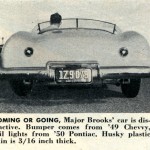
This Must Have Been A Futuristic Design For The Times. Caption Reads, “Coming Or Going, Major Brooks’ Car is Distinctive. Bumper Comes From 1949 Chevy, Tail Lights From a 1950 Pontiac. Husky Plastic Skin Is 3/16 Inch Thick.”
Second: There was not consistency in the use of the term “fiberglass” in many early articles. In this article they talked about it as “Plexiglass.” I’ve seen this form of construction referred to as building “plastic” cars, “glass-fiber” cars, and variation of the spelling “fiberglass / fiberglas” too. This is an early article, though, and it may be unique in referring to the material as “Plexiglas.” Rick D’Louhy and I continue to look for different variations of how people referred to these cars, and we’ll share the final results we collect in our upcoming Forgotten Fiberglass book.
Summary:
I hope you’ve enjoyed the review of today’s article from Popular Science. The Dynamic Duo of Bill Tritt and Eric Irwin of Costa Mesa, California really accomplished something special in the early days of fiberglass and postwar sports car history in America. Gentleman….we owe you a debt of gratitude.
Hope you enjoyed the story, and until next time…
Glass on gang…
Geoff
——————————————————————–
Click on the Images Below to View Larger Pictures
——————————————————————-
- I Love The Detail In These Captions. Here It Says, “Instead of Lowering Frame, Irwin Removed X member and Sits Inside Chassis. Seats Are Adjustable Fiat-Balila Buckets. Instrument Panel Is From 1940 Caddy.”
- Detail Shown In This Caption On The Lancer Says, “Three Levers Control Gear Shifting And Overdrive. One on Left Is For Low And Reverse, Middle Is For Second And High, Right For Overdrive. Upholstery Is Black Leather.”
- This Photo Shows Ken Brooks At Work On The G2. “Hood Panel Lifts Right Off, Providing Easy Access to Engine. The Power Plant Is A Modified L-Head Four Cylinder 1941 Willys With a 7.5 to 1 Compression Ratio.”
- This Must Have Been A Futuristic Design For The Times. Caption Reads, “Coming Or Going, Major Brooks’ Car is Distinctive. Bumper Comes From 1949 Chevy, Tail Lights From a 1950 Pontiac. Husky Plastic Skin Is 3/16 Inch Thick.”

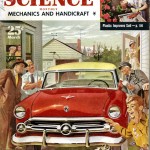
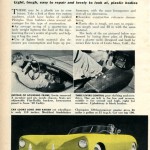
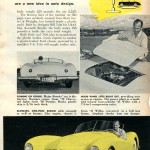
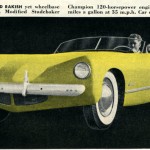
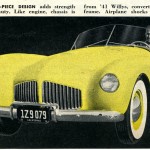
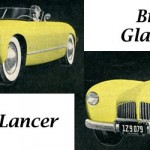
This site is protected by reCAPTCHA and the Google Privacy Policy and Terms of Service apply.